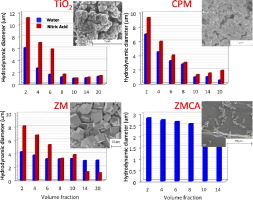当前位置:
X-MOL 学术
›
Powder Technol.
›
论文详情
Our official English website, www.x-mol.net, welcomes your
feedback! (Note: you will need to create a separate account there.)
Influence of shape and surface charge on the sedimentation of spheroidal, cubic and rectangular cuboid particles
Powder Technology ( IF 4.5 ) Pub Date : 2017-12-01 , DOI: 10.1016/j.powtec.2017.09.002 Neepa Paul , Simon Biggs , Jessica Shiels , Robert B. Hammond , Michael Edmondson , Lisa Maxwell , David Harbottle , Timothy N. Hunter
Powder Technology ( IF 4.5 ) Pub Date : 2017-12-01 , DOI: 10.1016/j.powtec.2017.09.002 Neepa Paul , Simon Biggs , Jessica Shiels , Robert B. Hammond , Michael Edmondson , Lisa Maxwell , David Harbottle , Timothy N. Hunter

|
Abstract This study investigated the complex settling behaviour of colloidal particles with varied surface charge and shape factors, of specific relevance to nuclear waste processing. Caesium phosphomolybdate (CPM), zirconium molybdate (ZM) and zirconium citromolybdate (ZMCA) were firstly synthesised, producing spheroidal, cubic and rectangular cuboidal morphologies respectively, and compared to agglomerated titania. While zeta-potential measurements indicated all simulant particles attained low isoelectric points, surface group leaching rendered suspensions very acidic, with CPM around its IEP, and ZM/ZMCA stable and positively charged. In sedimentation tests at various concentrations in water and 2 M HNO3, CPM and titania were found to settle with extremely high hindered settling exponents, consistent with aggregated structures. Exponents for ZM and ZMCA in water were both also well above values for spherical particles; however, this was assumed to be due to heightened drag effects from relative shape factors, rather than aggregation. ZMCA in particular showed a very high exponent of ~ 11.4, due to the propensity for the rod-like particles to settle in a flat conformation. For ZM in acid, double layer compression from the high electrolyte aggregated the dispersions, correlating to a significant increase in the settling exponent. An extended Stokes relationship was additionally used to understand theoretical limits of shape and aggregation on particle size prediction from hindered settling curves. Importantly, calculated sizes were consistent for the stable ZM and ZMCA in water, despite their non-sphericity and enhanced drag. The relationship failed however with agglomerated suspensions, highlighting its application as a general stability test for sedimenting dispersions.
中文翻译:

形状和表面电荷对球形、立方体和长方体颗粒沉降的影响
摘要 本研究调查了具有不同表面电荷和形状因素的胶体颗粒的复杂沉降行为,与核废料处理特别相关。首先合成了磷钼酸铯 (CPM)、钼酸锆 (ZM) 和柠檬酸钼酸锆 (ZMCA),分别产生了球形、立方体和长方体形貌,并与团聚的二氧化钛进行了比较。虽然 zeta 电位测量表明所有模拟粒子都达到了低等电点,但表面基团浸出使悬浮液非常酸性,CPM 围绕其 IEP,ZM/ZMCA 稳定并带正电。在不同浓度的水和 2 M HNO3 的沉降测试中,发现 CPM 和二氧化钛以极高的受阻沉降指数沉降,与聚集结构一致。ZM 和 ZMCA 在水中的指数也远高于球形颗粒的值;然而,这被认为是由于相对形状因素的阻力效应增强,而不是聚集。特别是 ZMCA 显示出非常高的指数,约为 11.4,这是由于棒状颗粒倾向于以平坦的构象沉淀。对于酸性中的 ZM,来自高电解质的双层压缩聚集了分散体,与沉降指数的显着增加相关。此外,还使用扩展的斯托克斯关系来了解形状和聚集的理论限制,以根据受阻沉降曲线预测粒度。重要的是,尽管 ZM 和 ZMCA 不是球形且阻力增加,但计算出的尺寸与水中的稳定 ZM 和 ZMCA 是一致的。
更新日期:2017-12-01
中文翻译:

形状和表面电荷对球形、立方体和长方体颗粒沉降的影响
摘要 本研究调查了具有不同表面电荷和形状因素的胶体颗粒的复杂沉降行为,与核废料处理特别相关。首先合成了磷钼酸铯 (CPM)、钼酸锆 (ZM) 和柠檬酸钼酸锆 (ZMCA),分别产生了球形、立方体和长方体形貌,并与团聚的二氧化钛进行了比较。虽然 zeta 电位测量表明所有模拟粒子都达到了低等电点,但表面基团浸出使悬浮液非常酸性,CPM 围绕其 IEP,ZM/ZMCA 稳定并带正电。在不同浓度的水和 2 M HNO3 的沉降测试中,发现 CPM 和二氧化钛以极高的受阻沉降指数沉降,与聚集结构一致。ZM 和 ZMCA 在水中的指数也远高于球形颗粒的值;然而,这被认为是由于相对形状因素的阻力效应增强,而不是聚集。特别是 ZMCA 显示出非常高的指数,约为 11.4,这是由于棒状颗粒倾向于以平坦的构象沉淀。对于酸性中的 ZM,来自高电解质的双层压缩聚集了分散体,与沉降指数的显着增加相关。此外,还使用扩展的斯托克斯关系来了解形状和聚集的理论限制,以根据受阻沉降曲线预测粒度。重要的是,尽管 ZM 和 ZMCA 不是球形且阻力增加,但计算出的尺寸与水中的稳定 ZM 和 ZMCA 是一致的。









































 京公网安备 11010802027423号
京公网安备 11010802027423号